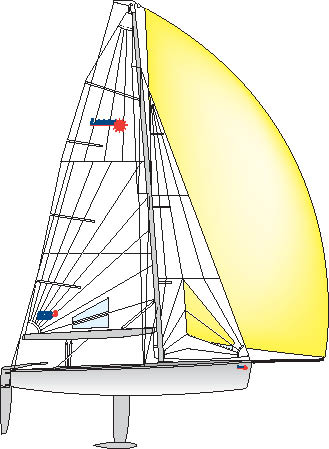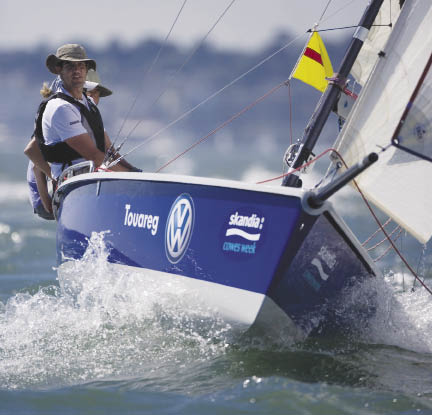Laser SB3
2008 June 5
June 2008
Sport Boat
 Designed by Tony Castro, the 20.2-foot Laser SB3 is probably the hottest new one-design fleet in Europe today. No doubt it is a great boat with appeal to intermediate and expert sailors, but this class has also benefited from a promotional campaign involving Volkswagen that pales any promotional effort I have seen before in one-design boats. Whatever the reason, the class has caught on and at this year's Primo Cup in Monaco it had 26 boats, and the class is expecting 100 boats at the 2008 Cowes Week.
Designed by Tony Castro, the 20.2-foot Laser SB3 is probably the hottest new one-design fleet in Europe today. No doubt it is a great boat with appeal to intermediate and expert sailors, but this class has also benefited from a promotional campaign involving Volkswagen that pales any promotional effort I have seen before in one-design boats. Whatever the reason, the class has caught on and at this year's Primo Cup in Monaco it had 26 boats, and the class is expecting 100 boats at the 2008 Cowes Week.
I'd call this a sport boat. It has 726 pounds of lead in a bulb at the end of a stainless steel-reinforced fin, so I think that takes it out of the dinghy category. The recommended crew weight is 594 pounds. That could be four people averaging 148 pounds each or three crewmembers averaging 198 pounds each. If I add the crew weight to the displacement of the boat I get an all up displacement of 1,905 pounds. The data says "hull weight" and not displacement, so with the extra weight of rig and gear the actual displacement may be greater than this. But I'll use this figure for a D/L of 106. The L/B is 2.88 indicating a beamy boat. Note how far aft the keel is. Draft is 4 feet, 11 inches. It sure looks a lot deeper than that in the renderings. The hull shape is moderate in every way, showing no hollows forward, a moderately firm bilge turn and a flat run. The Laser "coffee can lid" hull-to-deck joint is not pretty and takes away from the overall loom of the boat to my eye. Note that there are stainless steel rails on the deck edge to prevent hiking. You will sit "in" this boat while racing and not "on" the boat with your legs dangling to weather. This will give the Laser SB3 appeal to older sailors who have hiked their last hike. The benefit of having a very athletic crew will be minimized. Keel and outboard rudder are easily retracted, making the SB3 an easy boat to trailer and launch.
 The rig features an aluminum mast and boom, but the bowsprit that nestles in a notch in the foredeck is carbon fiber. The shrouds are swept and there are cap shrouds that go to the masthead to help support the large asymmetrical chute. The SA/D of this design, using the total sail area figures for mainsail and jib provided in the data, is 30.50. I suspect if I did have I, J, E and P this ratio may drop to around 26.00. But it's only a number. The backstay is a split tackle led to eyebolts on the transom corners. Note the inverted vang, or "gnav." This style of vang started 40 years ago. I remember seeing it on OK dinghies when I was in high school. The inverted vang pushes the boom down rather than pulling it down. It does muck up the mainsail shape at the tack a bit but it's nice to get the vang away from the crew's working area. All Laser SB3s come with stock one-design Hyde sails as standard. Main and jib are both Mylar. The mainsail is non-reefable. There are large windows in both main and jib for excellent visibility while racing.
The rig features an aluminum mast and boom, but the bowsprit that nestles in a notch in the foredeck is carbon fiber. The shrouds are swept and there are cap shrouds that go to the masthead to help support the large asymmetrical chute. The SA/D of this design, using the total sail area figures for mainsail and jib provided in the data, is 30.50. I suspect if I did have I, J, E and P this ratio may drop to around 26.00. But it's only a number. The backstay is a split tackle led to eyebolts on the transom corners. Note the inverted vang, or "gnav." This style of vang started 40 years ago. I remember seeing it on OK dinghies when I was in high school. The inverted vang pushes the boom down rather than pulling it down. It does muck up the mainsail shape at the tack a bit but it's nice to get the vang away from the crew's working area. All Laser SB3s come with stock one-design Hyde sails as standard. Main and jib are both Mylar. The mainsail is non-reefable. There are large windows in both main and jib for excellent visibility while racing.
Is the Laser SB3 fast? Everyone who sails it says it is. The boat can be sailed fully powered up in 12 knots and will do 5.5 knots hard on the wind. Light air performance will be stellar. Sailing in 20 knots will require some deft sail handling but, with enough wind, speeds of 20 knots should be expected.
Obviously Tony Castro has a hit on his hands.
Sport Boat
 Designed by Tony Castro, the 20.2-foot Laser SB3 is probably the hottest new one-design fleet in Europe today. No doubt it is a great boat with appeal to intermediate and expert sailors, but this class has also benefited from a promotional campaign involving Volkswagen that pales any promotional effort I have seen before in one-design boats. Whatever the reason, the class has caught on and at this year's Primo Cup in Monaco it had 26 boats, and the class is expecting 100 boats at the 2008 Cowes Week.
Designed by Tony Castro, the 20.2-foot Laser SB3 is probably the hottest new one-design fleet in Europe today. No doubt it is a great boat with appeal to intermediate and expert sailors, but this class has also benefited from a promotional campaign involving Volkswagen that pales any promotional effort I have seen before in one-design boats. Whatever the reason, the class has caught on and at this year's Primo Cup in Monaco it had 26 boats, and the class is expecting 100 boats at the 2008 Cowes Week.I'd call this a sport boat. It has 726 pounds of lead in a bulb at the end of a stainless steel-reinforced fin, so I think that takes it out of the dinghy category. The recommended crew weight is 594 pounds. That could be four people averaging 148 pounds each or three crewmembers averaging 198 pounds each. If I add the crew weight to the displacement of the boat I get an all up displacement of 1,905 pounds. The data says "hull weight" and not displacement, so with the extra weight of rig and gear the actual displacement may be greater than this. But I'll use this figure for a D/L of 106. The L/B is 2.88 indicating a beamy boat. Note how far aft the keel is. Draft is 4 feet, 11 inches. It sure looks a lot deeper than that in the renderings. The hull shape is moderate in every way, showing no hollows forward, a moderately firm bilge turn and a flat run. The Laser "coffee can lid" hull-to-deck joint is not pretty and takes away from the overall loom of the boat to my eye. Note that there are stainless steel rails on the deck edge to prevent hiking. You will sit "in" this boat while racing and not "on" the boat with your legs dangling to weather. This will give the Laser SB3 appeal to older sailors who have hiked their last hike. The benefit of having a very athletic crew will be minimized. Keel and outboard rudder are easily retracted, making the SB3 an easy boat to trailer and launch.
 The rig features an aluminum mast and boom, but the bowsprit that nestles in a notch in the foredeck is carbon fiber. The shrouds are swept and there are cap shrouds that go to the masthead to help support the large asymmetrical chute. The SA/D of this design, using the total sail area figures for mainsail and jib provided in the data, is 30.50. I suspect if I did have I, J, E and P this ratio may drop to around 26.00. But it's only a number. The backstay is a split tackle led to eyebolts on the transom corners. Note the inverted vang, or "gnav." This style of vang started 40 years ago. I remember seeing it on OK dinghies when I was in high school. The inverted vang pushes the boom down rather than pulling it down. It does muck up the mainsail shape at the tack a bit but it's nice to get the vang away from the crew's working area. All Laser SB3s come with stock one-design Hyde sails as standard. Main and jib are both Mylar. The mainsail is non-reefable. There are large windows in both main and jib for excellent visibility while racing.
The rig features an aluminum mast and boom, but the bowsprit that nestles in a notch in the foredeck is carbon fiber. The shrouds are swept and there are cap shrouds that go to the masthead to help support the large asymmetrical chute. The SA/D of this design, using the total sail area figures for mainsail and jib provided in the data, is 30.50. I suspect if I did have I, J, E and P this ratio may drop to around 26.00. But it's only a number. The backstay is a split tackle led to eyebolts on the transom corners. Note the inverted vang, or "gnav." This style of vang started 40 years ago. I remember seeing it on OK dinghies when I was in high school. The inverted vang pushes the boom down rather than pulling it down. It does muck up the mainsail shape at the tack a bit but it's nice to get the vang away from the crew's working area. All Laser SB3s come with stock one-design Hyde sails as standard. Main and jib are both Mylar. The mainsail is non-reefable. There are large windows in both main and jib for excellent visibility while racing.Is the Laser SB3 fast? Everyone who sails it says it is. The boat can be sailed fully powered up in 12 knots and will do 5.5 knots hard on the wind. Light air performance will be stellar. Sailing in 20 knots will require some deft sail handling but, with enough wind, speeds of 20 knots should be expected.
Obviously Tony Castro has a hit on his hands.

Comments